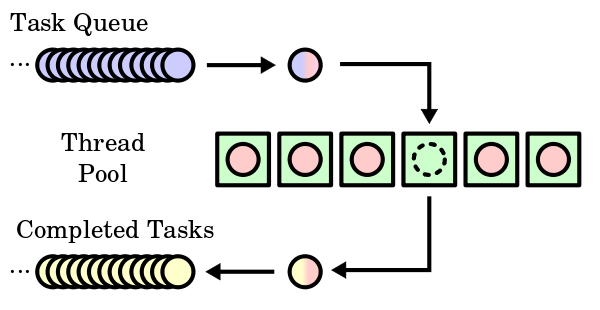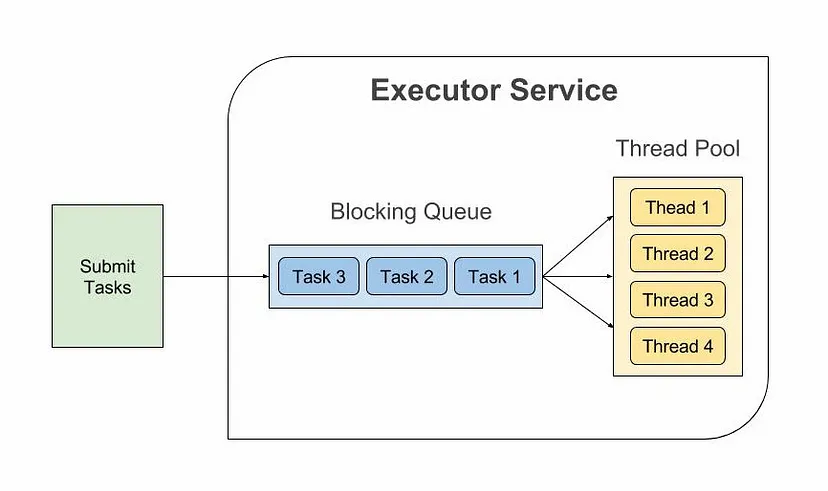ThreadPool & ExecutorService
1. Thread Pool
1.1 Thread Pool
Thread Pool은 동시에 여러 작업을 효율적으로 실행 및 관리하기 위해 서버에서 만드는 Thread의 모음입니다. Thread Pool을 이용하여 각 작업에 대해 새로운 Thread를 생성하는 대신 Thread Pool에 이미 생성 되어 있는 Thread를 재사용합니다.

![]()
- Thread Pool은 여러 개의 Thread를 유지, 관리함
- Thread Pool내에 있는 Thread들은 작업이 할당되기를 기다림
- 장점
- Thread를 생성/수거하는데 드는 비용 감소
- 이전의 Thread를 재사용할 수 있음
- 작업 딜레이가 발생하지 않음
- 작업 요청시 이미 Thread가 대기 중인 상태
- Thread를 생성/수거하는데 드는 비용 감소
- 단점
- Memory 낭비가 발생할 수 있음
- Thread를 너무 많이 생성해 두고 사용하지 않을 경우
- 최적의 Thread Pool Size를 설정하기 어려움
- Memory 낭비가 발생할 수 있음
1.2 Structure in Java

![]()
- Executors Class를 통해 생성한 Thread Pool은 ExecutorService interface를 구현한 instance
- Blocking Queue에서 작업을 꺼내 Thread에 전달
- Thread Pool instance에는 BlockingQueue, Worker Thread, HashSet이 존재
- Blocking Queue : 처리할 작업들이 들어있는 곳
- HashSet : Worker Thread들이 담긴 곳
2. Executors, ExectorService
Java에서는 Thread Pool을 사용할 수 있도록 java.util.concurrent.Executors Class와 java.util.concurrent.ExecutorService Interface를 지원합니다. Executors에서 제공하는 static method들을 통해 ExecutorService 구현 instance를 만들어서 사용할 수 있습니다.
- JDK 1.5부터 java.util.concurrent pacakge를 제공합니다.
- java.util.concurrent
- Executors class
- static factory method를 제공
- newFixedThreadPool
- newCachedThreadPool
- newScheduledThreadPool
- newSingleThreadExecutor
- static factory method를 제공
- ExecutorService interface
- Thread Pool이 제공하는 기능들을 정의
- execute()
- Runnable을 작업 Queue에 저장
- return 없음
- ExecutorException 발생할 경우 Thread 종료 및 Thread 제거, 새로운 Thread 생성
- submit()
- Runnable or Callable 작업 Queue에 저장
- return 있음(Future<?>, Future
) - ExecutorException 발생할 경우 Thread는 종료되지 않고 다음 작업을 위해 재사용
- shutdown()
- 더 이상 작업을 받지 않고 처리중인 작업 모두 완료 후 Thread Pool을 종료
- shutdownNow()
- 모든 Thread가 동시에 종료되는 것을 보장하지 않고 즉시 종료 시도
- 실행되지 않은 작업을 반환
- ThreadPoolExecutor class
- ExecutorService Interface의 구현체 class
- CompletionService Interface
- poll(), take()를 이용하여 처리완료된 작업만 통보 가능
- Executors class
2.1 ThreadPoolExecutor
public class ThreadPoolExecutor extends AbstractExecutorService {
public ThreadPoolExecutor(int corePoolSize,
int maximumPoolSize,
long keepAliveTime,
TimeUnit unit,
BlockingQueue<Runnable> workQueue,
ThreadFactory threadFactory,
RejectedExecutionHandler handler) {
if (corePoolSize < 0 ||
maximumPoolSize <= 0 ||
maximumPoolSize < corePoolSize ||
keepAliveTime < 0)
throw new IllegalArgumentException();
if (workQueue == null || threadFactory == null || handler == null)
throw new NullPointerException();
this.corePoolSize = corePoolSize;
this.maximumPoolSize = maximumPoolSize;
this.workQueue = workQueue;
this.keepAliveTime = unit.toNanos(keepAliveTime);
this.threadFactory = threadFactory;
this.handler = handler;
}
}
- corePoolSize : Thread Pool 내에서 반드시 존재해야하는 Thread 개수
- maximumPoolSize : Thread Pool에 저장할 수 있는 최대 Thread 개수
- keepAliveTime : Thread 수가 Core 수보다 많을 때 쉬는 Thread가 종료되기 전에 새 작업을 기다리는 최대 시간
- uint : keepAliveTime의 시간 단위
- workQueue : 처리되야 하는 작업들이 저장되있는 Queue
- threadFactory : Thread 생성 시 사용하는 Factory instance
- handler : Queue 용량이 초과되어 작업 실행이 block될 때 사용되는 handler instance
2.3 ExecutorService
public interface ExecutorService extends Executor {
void shutdown();
List<Runnable> shutdownNow();
boolean isShutdown();
boolean isTerminated();
boolean awaitTermination(long timeout, TimeUnit unit) throws InterruptedException;
<T> Future<T> submit(Callable<T> task);
<T> Future<T> submit(Runnable task, T result);
Future<?> submit(Runnable task);
<T> List<Future<T>> invokeAll(Collection<? extends Callable<T>> tasks) throws InterruptedException;
<T> List<Future<T>> invokeAll(Collection<? extends Callable<T>> tasks,long timeout, TimeUnit unit) throws InterruptedException;
<T> T invokeAny(Collection<? extends Callable<T>> tasks) throws InterruptedException, ExecutionException;
<T> T invokeAny(Collection<? extends Callable<T>> tasks, long timeout, TimeUnit unit) throws InterruptedException, ExecutionException, TimeoutException;
}
2.2 Executors
2.2.1 Cached Thread Pool
public class Executors {
public static ExecutorService newCachedThreadPool() {
return new ThreadPoolExecutor(0, Integer.MAX_VALUE,
60L, TimeUnit.SECONDS,
new SynchronousQueue<Runnable>());
}
}
- Thread를 Caching하는 ThreadPoolExecutor instance
- Thread Pool에서 반드시 유지되어야 하는 코어 Thread 개수 0
- 60s 동안 작업이 없으면 Thread Pool에서 제거
- SynchronousQueue 인스턴스에 작업을 담음
- 필요할 때 필요한 만큼 Thread를 생성
- Thread를 개수 제한 없이 무한정 생성해서 폭발적으로 증가할 수 있음
//Test code
void submitTasks(int taskAmount, ExecutorService executorService, Runnable runnable) {
for (int index = 0; index < taskAmount; index++) {
executorService.submit(runnable);
}
}
void threadExampleCode() {
int taskAmount = 20;
ExecutorService executorService = Executors.newCachedThreadPool();
submitTasks(taskAmount, executorService, () -> {
log.info("Task running");
});
}
- 작업이 들어올 때 모두 다른 Thread 사용
- 작업을 모두 전달한 시점의 Thread Pool Size는 20
2.2.2 Fixed Thread Pool
public class Executors {
public static ExecutorService newFixedThreadPool(int nThreads) {
return new ThreadPoolExecutor(nThreads, nThreads,
0L, TimeUnit.MILLISECONDS,
new LinkedBlockingQueue<Runnable>());
}
}
- 고정된 Thread 개수를 생성하는 ThreadPoolExecutor instance
- Thread Pool에서 반드시 유지되어야 하는 코어 Thread 개수 nThreads 값
- 0s 동안 작업이 없으면 Thread 종료
- 작업이 없을 때 작업을 얻을 때까지 Thread들이 대기
- LinkedBlockingQueue 인스턴스에 작업을 담음
- CPU 코어 수를 기준으로 생성하면 좋음
//Test code
void submitTasks(int taskAmount, ExecutorService executorService, Runnable runnable) {
for (int index = 0; index < taskAmount; index++) {
executorService.submit(runnable);
}
}
void threadExampleCode() {
int taskAmount = 20;
ExecutorService executorService = Executors.newFixedThreadPool(10);
submitTasks(taskAmount, executorService, () -> {
log.info("Task running");
});
}
- 20개의 작업을 10개의 Thread가 나눠서 수행
- 작업을 모두 전달한 시점의 Thread Pool Size는 10
2.2.3 Scheduled Thread Pool
2.2.3.1 if CORE_FULL_SIZE > 0
public class Executors {
public static ScheduledExecutorService newScheduledThreadPool(int corePoolSize) {
return new ScheduledThreadPoolExecutor(corePoolSize);
}
}
- 일정 시간 뒤에 실행되는 작업, 주기적으로 실행되는 작업에 사용하는 ScheduledThreadPoolExecutor instance
- Thread Pool에서 반드시 유지되어야 하는 코어 Thread 개수 corePoolSize 값
- 10s 동안 작업이 없으면 Thread 종료
- 작업이 없을 때 작업을 얻을 때까지 Thread들이 대기
- DelayedWorkQueue 인스턴스에 작업을 담음
- CPU 코어 수를 기준으로 생성하면 좋음
//Test code
void submitTasks(int taskAmount, ExecutorService executorService, Runnable runnable) {
for (int index = 0; index < taskAmount; index++) {
executorService.submit(runnable);
}
}
void threadExampleCode() {
int taskAmount = 20;
ScheduledExecutorService executorService = Executors.newScheduledThreadPool(10);
executorService.schedule(() -> {
log.info("Scheduled Task");
}, 2000, TimeUnit.MILLISECONDS);
submitTasks(taskCount, executorService, () -> {
log.info("Task running");
});
}
- 20개의 작업을 10개의 Thread가 나눠서 수행
- 작업을 모두 전달한 시점의 Thread Pool Size는 10
- 2s 뒤에 지정된 작업 수행
2.2.3.1 if CORE_FULL_SIZE = 0
2.2.4 Single Thread Pool
public class Executors {
public static ExecutorService newSingleThreadExecutor() {
return new FinalizableDelegatedExecutorService
(new ThreadPoolExecutor(1, 1,
0L, TimeUnit.MILLISECONDS,
new LinkedBlockingQueue<Runnable>()));
}
}
- Thread가 1개인 ThreadPool
- 실패할 경우 새로운 Thread 생성하지 않음
Reference
- https://en.wikipedia.org/wiki/Thread_pool
- https://www.baeldung.com/thread-pool-java-and-guava
- https://cheershennah.tistory.com/170
- https://change-words.tistory.com/entry/Tread-Pool#google_vignette
- https://velog.io/@backtony/Java-ExecutorService%EC%99%80-ForkJoinPool
- https://medium.com/@itsmynameangad/java-build-your-own-custom-executorservice-threadpool-213e46159326
- https://jeong-pro.tistory.com/188
